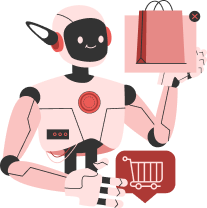- A Look at Australia’s eCommerce Landscape
- 10+ Ways AI is Helping Australian eCommerce Businesses Scale Faster
- 1. Personalized Shopping Experiences
- 2. Predictive Inventory Management
- 3. Dynamic Pricing
- 4. Automated Customer Support
- 5. Fraud Detection and Prevention
- 6. Visual Search and Image Recognition
- 7. Sentiment Analysis
- 8. Smart Marketing Automation
- 9. Voice Commerce
- 10. Warehouse Robotics and Process Automation
- 11. AI-Based Supply Chain Optimization and Sustainability
- Types of AI Technologies Used in eCommerce
- AI Use Cases in eCommerce With Real-Life Examples
- Personalized Shopping Experience
- AI-Powered Chatbots for Customer Support
- Enhanced Inventory Management with AI
- Automated Pricing Optimization
- AI for Fraud Prevention
- AI Integration Across Leading eCommerce Platforms
- Key Steps to Implement AI in an eCommerce Business
- Define Clear Business Goals
- Evaluate Existing Strengths
- Collect and Organize Data
- Choose the Right AI Tools
- Start with Pilot Projects
- Integrate with Pre-Existing Systems
- Train Staff and Align Teams
- Measure Results and Repeat
- Scale Within the Organization
- How to Overcome AI Challenges in eCommerce for Better Results
- Data Privacy and Security Concerns
- Integration into the Legacy Systems
- Lack of Skilled Talent
- Customer Resistance to AI
- Kickstart Your AI Implementation in eCommerce with Appinventiv
- FAQs
Key takeaways:
- The application of AI in Australian eCommerce is rapidly changing traditional eCommerce approaches, as it is used to personalize shopping, automate operations, and optimize prices.
- There is an apparent change in consumer behavior, with almost half of Australians already having access to AI assistants to assist in online shopping.
- Intelligent AI applications can help companies increase sales, enhance customer experience, and remain competitive in the market.
- Retailers need to embrace AI more than ever, given the government support and the availability of technology.
Across major Australian cities like Sydney, Melbourne, and Brisbane, shoppers are embracing AI-driven tools to make their online experiences smarter and more personal. The retail industry is transforming with the adoption of artificial intelligence in terms of virtual assistants that recommend the ideal outfit, and AI-based platforms that compare prices of different retailers. Such innovations are not only related to convenience, but it is a radical change in the interaction of consumers with eCommerce platforms.
A recent PayPal study indicates that close to 48% of all Australians have used AI assistants to search online shops. This number increases to 66% of people under 45 in Australia, which demonstrates a generational change in the use of AI in retail.
AI can be applied in the eCommerce field in more ways than with product recommendations. AI technologies allow creating a personalized shopping experience through the analysis of consumer behavior, prediction, and the provision of specific recommendations. This not only increases customer satisfaction but is also a boost to sales and brand loyalty.
Recognizing the transformative potential of AI, the Australian Government has introduced initiatives to support businesses in adopting AI technologies responsibly. The Voluntary AI Safety Standard provides guidance for businesses developing and deploying AI systems, ensuring they do so safely and ethically
With the further evolution of AI, it is bound to have an increase in the impact on Australian eCommerce. To discover how companies can use AI to grow at a faster and more efficient rate, take a quick walk-through of this detailed guide and understand the top 10+ ways in which AI is transforming the Australian eCommerce landscape.
Capture this growing audience by integrating AI-powered search in your eCommerce platform
A Look at Australia’s eCommerce Landscape
The Australian eCommerce and retail section has been steadily growing over the past years, and it is fitting as a strong indication of a change in consumer behavior that favors online shopping. Online retail sales amounted to $4,703.8m in June 2025, 13% higher than the online retail sales made in the same period the year before (Source: ABS). This development underscores the fact that eCommerce has emerged as a key part of the Australian retail ecosystem.
A number of issues have led to this growth. Online shopping has now become simpler and more accessible with the growth of smartphone penetration and higher internet speeds. Another trend is consumers’ preference for diversity, costs, and options on the online platform. Businesses, in turn, are investing in digital infrastructure, improving user experiences, providing hassle-free checkout measures, and increasing product lines to attract and keep customers.
The market is also driven by generational trends. Mobile and social commerce are being rapidly adopted by millennials and Gen Z, with older groups slowly moving towards convenient online shopping. Digital wallets and buy-now-pay-later apps have also been essential in facilitating these changes through the use of payment technology.
10+ Ways AI is Helping Australian eCommerce Businesses Scale Faster
AI is currently accelerating Australian businesses, and the eCommerce sector is not an exception. The eCommerce sector in Australia is growing at a very rapid pace, with retailers currently using smart systems to personalize customer interfaces, automate their logistics, and understand customer behavior. Let’s check the top 10+ ways through which AI is transforming the eCommerce business in Australia.
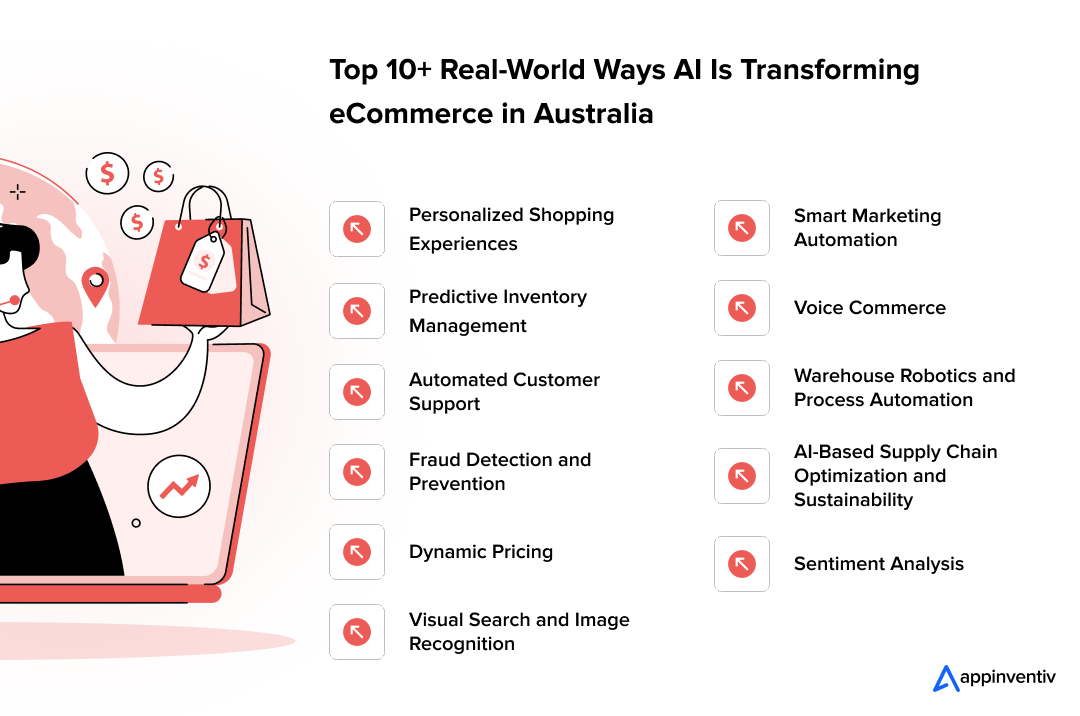
1. Personalized Shopping Experiences
The application of AI in eCommerce in Australia is changing how individuals learn and make decisions about products. The artificial intelligence systems examine activities such as browsing history, purchase frequency, and the time spent on different pages, then apply this data to make real-time suggestions that capture the exact intention of each shopper. It is not a more individual approach that only boosts sales. It also leaves the customers satisfied since they do not get irrelevant suggestions.
More developed models continue to learn each time they interact, and thus, they become more accurate with time. For brands, this means more customer interaction and high customer repeat value without incurring large marketing expenditures.
2. Predictive Inventory Management
Demand forecasting has become more precise with AI for eCommerce in Australia, which analyzes historical data, seasonal patterns, and market shifts to predict sales volume. It studies past trends, seasonal trends, and market trends to forecast the volume of sales. The retailers can now easily predict which items to sell quickly and which will not sell, allowing them to adjust their purchase plans accordingly.
The AI-based prediction systems also monitor the suppliers’ schedules and logistics issues to maintain the balance of the stock level. This basic operation helps companies reduce wastage, clear up the warehouse, and maintain a steady stock of products in both virtual and physical shops.
3. Dynamic Pricing
Artificial intelligence for Australian eCommerce businesses assists retailers in responding to market changes immediately. AI algorithms consider many variables, including competitor pricing, existing customer demand, and even the time of the day, and automatically determine the best prices.
These systems experiment with new prices all the time and implement the findings to optimize revenue and competitiveness. Retailers with dynamic pricing will experience higher profit margins, and this will not result in diminished customer loyalty, as the prices are not arbitrary decisions but are based on data. With dynamic pricing features in place, you can ensure an increased customer loyalty and retention.
Also Read: How Much Does it Cost to Build a Customer Loyalty Program App Like Flybuys?
4. Automated Customer Support
eCommerce businesses have also been made by AI to streamline their customer service operations and make them scalable. Virtual assistants and smart chatbots can now respond to questions about product availability, order status, and returns with minimal human intervention. These systems comprehend the natural language and can adapt the tone of the user, providing quick and uniform responses.
By leveraging AI for eCommerce businesses, retailers can now enjoy reduced service prices while customers receive reliable support 24 hours a day. In the long run, such conversational AI systems will also connect to CRM systems to respond more personally, thus providing an absolutely seamless service experience.
5. Fraud Detection and Prevention
Artificial Intelligence in eCommerce has actually enhanced fraud prevention. The AI tracks transactions to determine whether they exhibit suspicious behavior. Artificial intelligence (AI) designs rapidly scan data entries such as type of device, location, and purchase frequency to identify suspicious activity in real-time.
This proactive fraud identification can assist retailers in preventing fraudulent transactions even before they occur, to keep revenue and customer trust. The machine learning algorithms also improve with each data cycle, reducing the number of false positives and ensuring that the rightful shoppers are not slowed down.
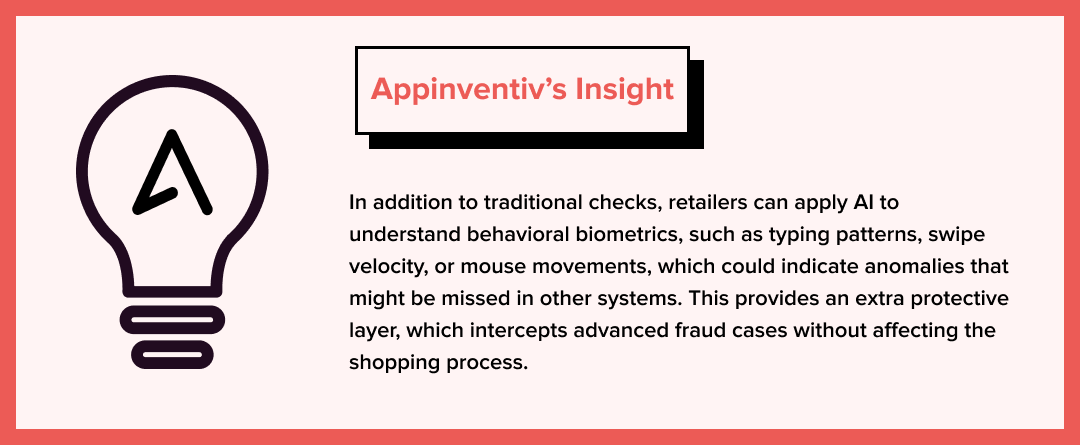
6. Visual Search and Image Recognition
Consumers increasingly rely on visual discovery tools, made possible by AI adoption in e-commerce. Users are no longer required to type lengthy product descriptions, but can now add a picture to search for matching or similar products. The AI operates in the background by processing texture, shape, and pattern data to provide highly accurate outcomes.
For retailers, this feature is an easy way to enhance the visibility of their products and simplify the process of using them, especially for those in the fashion, home decor, and lifestyle segments. The higher the number of images the AI is trained on, the higher its recognition accuracy will be.
7. Sentiment Analysis
With the help of AI-driven eCommerce in Australia, retailers can monitor their brand reputation more intelligently. AI-powered sentiment analysis collects and processes words that customers say on various platforms, such as reviews, chat logs, and social media.
Assuming the tone, the intent, and any arising issues can be discovered soon, marketing teams can respond quickly. This understanding helps businesses to perfect their communication, modify product lines, and churn customers. The information also informs the long-term brand strategy by revealing the way customer expectations are evolving.
8. Smart Marketing Automation
Conversational AI in eCommerce retailers is leveraging AI to enhance their methods of acquiring and retaining their customers. The tools utilize engagement data to divide audiences, determine the optimal time to deliver a message, and automate outreach regarding email, SMS, and chat. AI-based marketing eliminates the guesswork, and the campaigns are based on customer behavior rather than on generic schedules.
It leads to an increase in click-through rates, conversion rates, and RoI that can be measured. Over time, companies do not have to expand their workforce to accommodate their custom marketing activities.
9. Voice Commerce
At the stage of the development of generative AI in eCommerce in Australia, voice-controlled shopping is one of the key trends of convenience. Smart assistants have accelerated the mode of search within consumers, where they can browse, compare prices, and make purchases without ever opening a browser.
AI makes these interactions very natural, and it can manage context, accents, and follow-up questions with ease. Voice commerce integration in eCommerce provides retailers with a competitive edge in terms of accessibility and user retention as mobile and home-based shopping keep increasing. It is also a technology that changes the way customers interact with brand ecosystems across platforms.
10. Warehouse Robotics and Process Automation
Implementing AI in eCommerce business logistics, automation has passed through digital operations. Robots have become intelligent and are used in picking, packing, and sorting to enhance the accuracy and throughput in the warehouse. These artificial intelligence systems memorize spatial plans and find the best routes to reduce fulfillment time.
In the case of big Australian retailers, this translates to quick delivery, a minimized number of manual mistakes, and less reliance on seasonal labor. By combining robotics with real-time order information, eCommerce companies will be able to scale their operations sustainably and meet the ever-increasing demand of consumers.
11. AI-Based Supply Chain Optimization and Sustainability
Sustainability has ceased to be a buzzword in the eCommerce industry in Australia; it is a competitive advantage. Artificial intelligence is currently an essential solution that will help retailers reduce waste, optimize their delivery patterns, and lessen their total carbon footprint.
Using different variables such as order density, location of a warehouse, traffic, and energy usage, AI systems will be able to offer the most efficient logistics routes and packaging. This reduces the emissions, besides reducing the cost of operations.
As an example, AI-based systems could forecast the warehouses required to stock certain goods to reduce the time it takes to make a delivery, and restocking driven by demand decreases surplus production. Australian retailers that combine these AI-driven insights into sustainability find it easier to meet ESG requirements and attract eco-conscious customers, boosting their margins in the process.
Types of AI Technologies Used in eCommerce
The current eCommerce is based on the general scope of AI technologies that collaborate to optimize operations, personalize customer interactions, and enhance decision-making. The tools are used to facilitate logistics, marketing, user experience, and analytics.
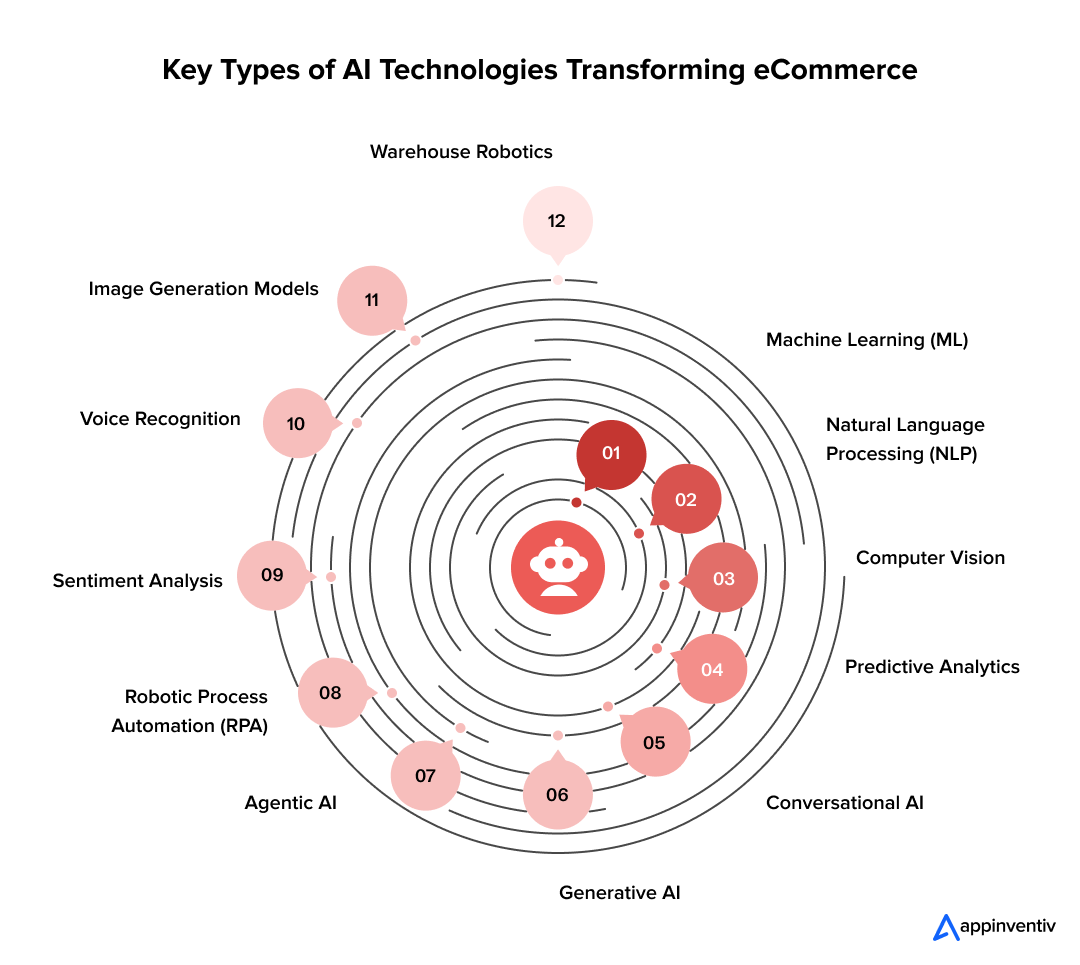
Machine Learning (ML): Machine learning allows systems to detect trends, forecast results, and become more precise as they evolve with time. It drives product recommendations, sales forecasting, and fraud detection.
Natural Language Processing (NLP): NLP assists computers in comprehending human language, which is the foundation of chatbots, search engines, and voice assistants, to make communication with the customer more natural.
Computer Vision: Computer vision is used to interpret images and videos to perform visual search, tag products, and content moderation to enhance discovery and consistency.
Predictive Analytics: Predictive models uses past data to predict demand, pricing opportunities, and customer behavior, and therefore enable a business to plan ahead.
Conversational AI: Conversational systems process inquiries, automate replies, and customize communication, which guarantees 24/7 customer service and minimal human intervention.
Generative AI: Generative tools generate new works, such as marketing content, product descriptions, and images, which relieve creative efforts and speed up the delivery of campaigns.
Agentic AI: Agentic AI is the next wave of automation, allowing systems to act independently towards specific business objectives. In eCommerce, it is able to integrate various AI systems, including chatbots, analytics engines, and marketing systems, to make decisions, perform activities, and automatically optimize its performance without any human supervision.
Robotic Process Automation (RPA): RPA can be used to automate rule-based activities associated with order processing, data entry, and reporting, enhancing the accuracy and saving staff time to work on higher-value activities.
Sentiment Analysis: Sentiment analysis applications define customer feedback on various platforms, enabling businesses to interpret public perception and make alterations.
Voice Recognition: Voice commerce applications enable a user to search, order, or reorder products by verbal command and enhance accessibility and convenience.
Image Generation Models: The online shopping process is now improved through the use of AI-generated visuals to generate realistic product images and virtual try-on options.
Warehouse Robotics: In warehouses, AI-controlled robots do picking, sorting, and packaging, accelerating the fulfillment, yet preserving consistency and precision.
AI Use Cases in eCommerce With Real-Life Examples
Artificial intelligence is the engine behind smarter recommendations, faster operations, and seamless customer journeys. Here are some of the popular use cases of AI in eCommerce with real-life examples:
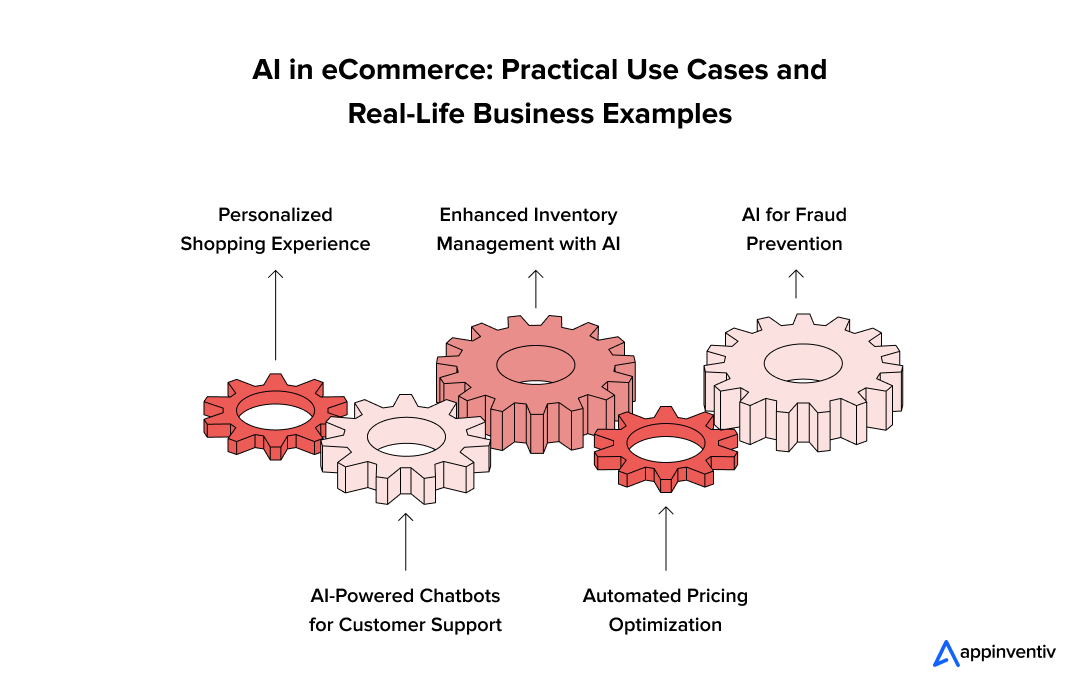
Personalized Shopping Experience
AI improves the shopping experience by using data to give individual product suggestions based on browsing history, past purchases, and preferences. This helps increase conversion rates and customer loyalty.
The Iconic is one of the biggest online fashion stores in Australia and employs AI-based recommendation systems to make the shopping process unique to the customer. The engine proposes products that are guided by the past browsing and purchase information of a customer, resulting in increased engagement and sales.
AI-Powered Chatbots for Customer Support
AI chatbots in Australia provide immediate customer service, responding to queries, monitoring orders, and giving individual shopping recommendations. Such chatbots save time and increase customer satisfaction by providing round-the-clock service.
Kogan, the widely known online store, implements AI chatbots to guide customers in handling frequent questions like order tracking, product details, and troubleshooting. The chatbot enables handling a large number of queries with the help of AI to enhance productivity and customer satisfaction.

Enhanced Inventory Management with AI
AI streamlines the inventory by examining customer demand, sales trends, and conditions in the market. It forecasts the type of products that will be stocked, which will bring about overstocking or stockouts.
Catch.com.au is an online company that benefits itself through AI and predicts product demand, and optimizes its inventory. Analyzing real-time data will keep the appropriate products in stock so that when there are high shopping seasons, there are improved sales as opposed to a high level of stockout.
Automated Pricing Optimization
The AI-based pricing platforms will modify the price of products according to their competitor analysis, market demand, and customer behavior. This will make the pricing competitive, and profit will be maximized.
JB Hi-Fi, an electronics eCommerce giant, applies AI to regulate the prices of its products automatically, depending on the price of its competitors, changes in demand, and seasonal variations. Through dynamic pricing, JB Hi-Fi remains competitive while maximizing revenue.
AI for Fraud Prevention
AI can process and identify suspicious activities during transactions in real time, preventing fraud in eCommerce businesses. By identifying fraudulent activities, AI agents increase the security of the business and its customers.
Temple and Webster is a furniture and homeware online company based in Australia that uses AI to detect and stop fraudulent transactions. AI tracks buying patterns, which will ensure that the company minimizes refunds and enhances the platform’s security.
Also Read: 10+ eCommerce Business Ideas to Launch in Australia in 2026
AI Integration Across Leading eCommerce Platforms
Modern eCommerce systems have introduced artificial intelligence deep within their system, allowing retailers to automate their systems, customize experiences, and make decisions informed by data without additional integrations. In fact, regardless of whether it is an embedded component or a third-party solution, AI has become a ubiquitous component across the major digital commerce networks.
The following is a summary of the use of AI on the popular eCommerce platforms:
| Platform | What the AI Does | Who Should Use It |
|---|---|---|
| BigCommerce | It uses AI tools (integrations) to get smarter data insights, personalize content, and run marketing automatically. The system has predictive tools that help with figuring out prices and managing stock. | Growing brands that sell their stuff across a bunch of channels. |
| Shopify & Shopify Plus | It gives you Shopify Magic for writing product descriptions, Shopify Inbox for better chat, plus lots of apps for product suggestions and automating tasks. | Small-to-mid-sized retailers who want to start using AI fast. |
| SAP Commerce Cloud | The AI is built right in, letting you see real-time analytics, guess where customers are in their buying journey, and automate your promotions. | Large companies that are dealing with complicated supply chains. |
| Odoo | This platform blends AI into both its main business software (ERP) and e-commerce. It offers chat help, automated content creation, and tools to predict what sales will look like. | Businesses that want one system where AI helps run all their operations together. |
| Adobe Commerce (Magento) | It runs on Adobe Sensei, which powers visual search, smart product suggestions, and automated merchandising. | Big companies that need lots of control and the option to deeply customize their AI. |
| Microsoft Dynamics 365 | It uses Copilot to help create content, make educated guesses using data, and get insights across different teams. | Businesses that sell through multiple channels and need AI to work with their finance and CRM tools. |
Key Steps to Implement AI in an eCommerce Business
Making AI a part of your eCommerce process is not just the addition of new tools but the redefinition of your business in terms of understanding and serving the customer. Starting with establishing clear objectives through to selecting the appropriate data infrastructure, every process is important in the success of the whole process. Here are the quick steps:
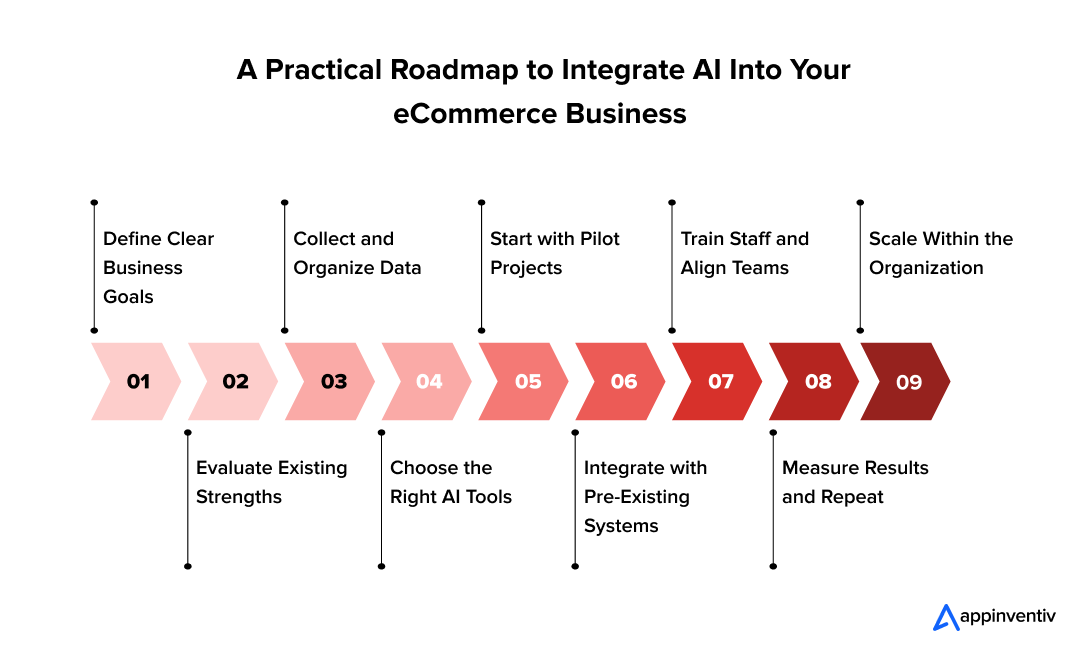
Define Clear Business Goals
Any AI strategy is built on the premise of establishing certain goals. Find the places where AI can make the biggest difference, be it through better personalization, automated customer support, better inventory management, or increased marketing effectiveness.
In the case of implementing AI in eCommerce in Australia, clear objectives would make sure that investment is relevant to the outcome that is measured, like increased conversion rates, better customer retention, or lower operational costs. Goals determine what technologies and measures to focus on as well.
Evaluate Existing Strengths
Analyze your current eCommerce platforms, processes used, and data management infrastructure. It is important to comprehend what works and the areas requiring improvement before incorporating AI.
For AI for eCommerce in Australia, this assessment helps determine whether existing systems can support machine learning, predictive analytics, or conversational AI in the Australian tech landscape. This also highlights areas where infrastructure upgrades may be necessary for smooth adoption.
Collect and Organize Data
AI relies on data, and its quality is directly related to results. Gather past sale information, customer behavior data, and product resources, clean, and organize them (cleaning and organizing information).
Artificial Intelligence for Australian eCommerce businesses relies on high-quality, properly structured information to implement predictive knowledge, personal recommendations, and efficient automated decision-making, transforming raw data into useful intelligence.
Choose the Right AI Tools
The choice of AI tools will make your implementation effective and scalable. Examples of alternatives include recommendation engines, NLP-driven chatbots, dynamic pricing engines, or AI-driven analytics platforms.
For AI for eCommerce businesses, the tool choice should balance functionality, ease of integration, and cost-effectiveness while matching your business objectives and operational readiness.
Start with Pilot Projects
Pilot projects enable companies to run AI on a small scale prior to full implementation, mitigate risk, and spot problems. Introduce AI to one department or process, track performance, and receive feedback.
Artificial Intelligence in eCommerce should be implemented in stages, as it allows the teams to test model predictions, quantify improvements, and experiment with deployment tactics until they are convinced that the AI has become an essential part of their organization.
Integrate with Pre-Existing Systems
To add value, you need to integrate your platform with ERP, CRM, and your inventory management and other marketing tools. Definite integration will ensure that AI knowledge activates an automatic response, updates a customer’s profile, and shares the information with departments.
AI adoption in e-commerce has to be properly planned to ensure data consistency and interoperability to enable AI solutions to work effectively without the need to interfere with the current workflow.
Train Staff and Align Teams
Technology is not the only way to achieve successful AI adoption; people play a significant role in it. Train employees on AI functionality, processes, and future results, and encourage inter-departmental cooperation between IT, marketing, operations, and customer service.
Combining human knowledge with AI intelligence ensures that solutions are implemented, insights are gained, and teams are confident in using AI tools to improve productivity.
Measure Results and Repeat
Regularly evaluate AI performance based on set KPIs, including conversion rates, average order value, and operational efficiency. Monitor the quality of predictive models, customer engagement rates, and workflow automation.
AI-based eCommerce app development is a dynamic process, and continuous control enables timely changes, optimizing campaigns, and constantly improving it to follow trends and make the most of it.
Scale Within the Organization
As soon as AI solutions can deliver measurable outcomes in pilot projects, they will expand their application to other business domains. Scaling ought to be gradual and well-managed, with every subsequent integration closely watched.
It becomes possible to use AI to assist other functions in the organization, like personalized marketing, customer support, and supply chain management, building a unified, AI-driven ecosystem throughout the organization.
Let our experts help you transform customer experiences by implementing the right steps for a successful integration
How to Overcome AI Challenges in eCommerce for Better Results
There are transformative benefits of AI for Australian eCommerce, and applying these technologies is not without challenges. The Australian eCommerce companies have a set of obstacles that should be surmounted in order to integrate AI successfully. The following are the main challenges of using AI in eCommerce and their resolutions:
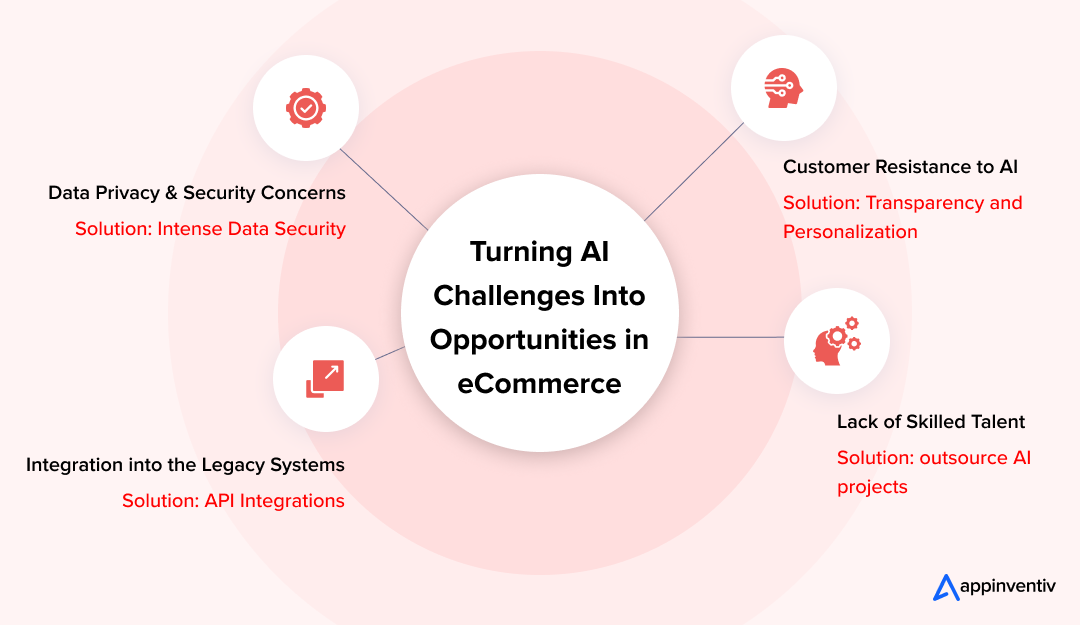
Data Privacy and Security Concerns
Challenge: The AI systems are based on massive amounts of sensitive customer information, raising serious privacy issues. As data privacy requirements increase, companies are expected to manage data safely and responsibly.
Solution: Use encryption and anonymization methods, and adhere to privacy legislation such as the Australian Privacy Act to build secure apps that protect customer data and other essential information from breach.
Integration into the Legacy Systems
Challenge: Some eCommerce enterprises have old systems which are not compatible with new AI technologies, posing challenges in integrating them.
Solution: API-based solutions can be used to integrate AI tools with existing systems stepwise rather than completely revamp everything at once.
Lack of Skilled Talent
Challenge: The supply of skilled AI professionals in Australia is limited, and so it is not easy to develop in-house AI skills by the eCommerce companies.
Solution: Outsource AI projects to third-party providers without necessarily hiring a full-time in-house team.
Customer Resistance to AI
Challenge: Customers may be reluctant to use AI-based tools, such as chatbots or automated systems, because they fear losing the human touch.
Solution: Let customers learn how AI can improve their experience and provide a hybrid solution in which AI and human interaction co-exist.
Kickstart Your AI Implementation in eCommerce with Appinventiv
AI is completely changing the way Australians shop online. It’s a huge chance for businesses to give customers super-personalized shopping experiences, simplify their operations, and scale up their growth quickly. Companies that use smart tools like AI systems for product suggestions, predictive data analysis, and conversational AI are better positioned to handle customer demands now and stay ahead of the competition.
The future of AI in eCommerce in Australia will also be shaped by evolving regulations such as the Privacy Act 1988, the Australian Consumer Law, and upcoming AI governance frameworks that promote transparency, data protection, and responsible innovation. It will also be defined by the advancements in the AI technology itself, along with the merger of other technologies within an eCommerce app.
As leaders in Artificial Intelligence development services in Australia, we have continuously helped big international brands smoothly add AI to their online retail systems for over a decade now. For instance, our partnership with IKEA made it much easier for shoppers to find products and improved the personalized suggestions across their stores.
Again, for Adidas, we helped them implement features like real-time inventory, secure checkout, and fun, loyalty-based games, which led to millions of downloads. We used AI for Edamama to create a trustworthy platform for parents, and 6th Street grew massively with a fashion app that used AI for style tips, better search, and local features.
Our decade of experience proves our legacy in building intuitive, high-performing apps that have garnered us a series of awards, with the latest being “Leader in AI Product Engineering and Digital Transformation” by The Economic Times.
As a reputed eCommerce app development company in Australia, we take immense pride in delivering tangible, measurable results for our clients. However, don’t just take our word for it; explore our client testimonials to discover how our solutions have driven transformative success across diverse industries.
Reach out to us today to start building your own AI-powered eCommerce app and get your business ready for whatever comes next.
FAQs
Q. How to implement AI for Australian eCommerce businesses?
A. The use of AI in eCommerce in Australia will start with determining which areas of the activity can be automated most beneficially, including customer service, stock management, and marketing. The first thing businesses can do is to launch AI-driven chatbots, recommendation engines, and predictive analytics applications, making sure that they are integrated with the current systems without violating ethical standards and legal regulations.
Q. How does AI improve customer experience in eCommerce?
A. Conversational AI in eCommerce is essential in improving customer experiences. Chatbots and virtual assistants offer immediate assistance, respond to questions, and learn as they facilitate item purchases, which decreases friction, enhances satisfaction, and boosts future purchase efforts.
Q. How can AI enhance personalization in eCommerce?
A. AI uses browsing history, purchase behavior, and preferences in order to provide ultra-personalized experiences. One-to-one product suggestions, specific deals, and personalized content guarantee that every interaction is different, increasing interaction and conversion rates and sales overall.
Q. What are the main benefits of using AI in eCommerce?
A. AI in retail and eCommerce is driving revolutionary changes that have not only boosted engagement but also increased RoI of Aussie businesses. For instance, AI agents for eCommerce in Australia are totally changing how Australian e-commerce companies operate. They’re helping businesses work smarter, grow quicker, and stay competitive in a marketplace that never slows down.
- Work Smarter: They make operations way more efficient by just doing all the boring, repetitive tasks automatically. This gives your staff the time back they need to really focus on the important, big-picture goals.
- Manage Inventory: The AI tools are great for keeping a better track of stock because they use smart guessing (forecasting). They predict customer demand, meaning you avoid those annoying problems of having shelves that are too empty or having way too much product sitting around.
- Fix Marketing: You can make your marketing efforts significantly better just by using the useful information you get from watching exactly what your customers are doing and buying.
- Make it Personal: These AI agents check customer data to figure out what each individual shopper is into. That allows you to give them truly personalized experiences with specific product ideas and custom deals just for them.
- Real Growth: The way to grow the business faster and beat the competition is by combining automation, analyzing the data, and letting AI help you make better, quicker choices.


- In just 2 mins you will get a response
- Your idea is 100% protected by our Non Disclosure Agreement.

AI Governance Consulting: How to Build Guardrails, Observability, and Responsible AI Pipelines
Key takeaways: Enterprises can no longer rely on principles alone; AI governance must be built into pipelines, model workflows, and decision systems from day one. Strong guardrails across training, inference, retrieval, and agentic actions reduce risks like hallucinations, data leakage, and prompt injection. AI observability is central to governance, giving leaders real-time visibility into drift,…

How to Build a Custom Multilingual Chatbot? Features, Process, Costs
Key takeaways: Multilingual Chatbots Drive Revenue Growth: Companies see higher conversion rates when customers can interact in their native language, with nearly 75% of global customers preferring to buy from websites in their preferred language. Beyond Translation to Cultural Intelligence: Successful implementations require cultural adaptation, not just language translation. Systems must understand context, emotion, and…

How Much Does It Cost to Build an AI App in Dubai?
Key takeaways: AI app costs in Dubai typically range from AED 80,000 for simple builds to AED 800,000+ for enterprise systems. Dubai is past AI experimentation, and not investing now means catching up later at higher cost. The real budget is driven by data, integrations, architecture, and compliance, not just app features. Hidden costs like…


























